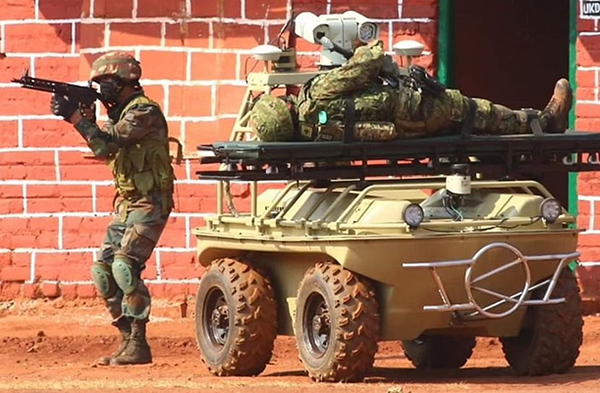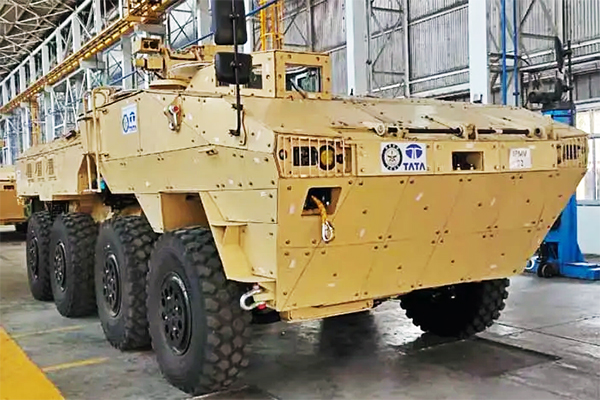Light Armoured Multipurpose Vehicles
The Indian Army is looking to buy around 800 light armoured multipurpose vehicles (LAMVs) for high altitude areas, deserts and plains. On 1 July, a Request for Information (RFI) was sent to several vendors for LAMVs which will be deployed with the mechanised and armoured units of the Indian Army. In the recent conflicts including the ongoing Russia-Ukraine war, when the US led troops were in Afghanistan or Iraq, these LAMVS proved that these are the “to-go” vehicles which are needed in a war zones where the troops need to be moved around and be protected from threats posed by small arms fire, hidden explosive devices and shell splinters.
The main requisite of the RFI that has been issued to identify the vendors here in India who can deliver the 800 vehicles from the time the contract is signed.
These vehicles will be in line with the government’s “Atmanirbhar Bharat” initiative and will be used for surveillance as well as reconnaissance operations once they are deployed in different terrains across the country. According to the RFI these LAMV should have adequate mobility, and should also be able to protect the troops inside.
Besides carrying troops these vehicles will also be used for carrying loads of ammunition, surveillance and communication systems to be used for mandated operational tasks.
Since the vehicles will be deployed in different terrains –desert, plains and high altitude they have to have the capability to issue early warning and intelligence and also be adaptable with drones.
For the first time, an Indian company TATA Motors had put on display LAMV at the DefExpo in New Delhi in 2014. This LAMV showcased its capability to be used for reconnaissance mobility, protection and firepower.
Infantry Protected Mobility Vehicle (IPMV)
In a bid to boost the capabilities of the Indian Army, made-in-India Infantry Combat Vehicles have been inducted into the forward areas in Ladakh. The combat vehicles, named Infantry Protected Mobility Vehicles (IPMVs), have been jointly developed by the Defence Research and Development Organisation (DRDO) and the Tata group.
The Tata Advanced Systems Limited (TASL) handed over the first lot of the indigenously developed Infantry Protected Mobility Vehicles (IPMVs) to then Chief of the Army Staff General Manoj Mukund Naravane at a ceremony in Pune in April this year. With this, the TASL became the first private sector company across the nation to produce and deliver wheeled armoured combat-ready vehicles for the armed forces.
These Infantry Protected Mobility Vehicles have been tried and tested in the mountainous terrain of the Ladakh region.
The vehicles include quick reaction fighting vehicle medium, infantry protected mobility vehicle, ultra-long-range observation system developed by the TASL and monocoque hull multi-role mine-protected armoured vehicle developed by Bharat Forge.
TASL’s in-house designed and developed remote-controlled weapon station with thermal sights and external add-on armour protection panels developed by the Defence Metallurgical Research Laboratory of the DRDO have also been fitted into the vehicle.
The vehicles are based on the strategic 8×8 Wheeled Armoured Platform (WhAP), indigenously designed and developed by the TASL along with the Vehicles Research and Development Establishment (VRDE), a unit of the DRDO.
These vehicles generally feature a v-hull-shaped underbelly with additional crew protection features such as four-point seat belts and seats suspended from the roof or sides of the vehicle. IMVs have been designed to resist small arms and explosives, but they cannot defeat heavy machine guns and cannon fires, or shaped charge attacks.
Many of these vehicles feature a machine gun on the roof, either on a ring mount or a remote weapon system.
Trials of AI-enabled Unmanned Vehicles
The Indian Army will soon conduct trials of indigenously developed artificial intelligence (AI)-enabled, unmanned all-terrain vehicles in Ladakh for surveillance and logistics operations. Trials will also be held in deserts in Rajasthan before the Army selects a final product and goes for large scale acquisition.

One of the vehicles under consideration has been developed by the Kalyani Group that runs on both batteries and motors. The vehicle was one of the 75 products that were on display at the defence ministry’s first AI symposium in Delhi on 11 July.
The vehicle can operate on battery for about six hours and on motor for 14 hours. It has an operational range of three kilometres and can carry a load of up to 500 kg. Additionally, day and night cameras, having a range of two kilometres, are mounted on the vehicle. This means one can see up to five kilometers from a command centre.
The vehicle has already undergone two trials with the infantry and the armoured units. The infantry used the vehicle to carry logistics such as weapons and ammunition, while the armoured units used it as a reconnaissance vehicle to track enemy positions. The unmanned vehicle will also be deployed for explosive detection and neutralisation of improvised explosive devices (IED).
The wheeled variants, both 4×4 and 6×6, are fully designed and developed indigenously while a tracked version is being built along with a European company.
The vehicle has multiple sensors for mapping, path planning and obstacle detection, and can operate in temperatures ranging from -20 degree to +50 Degrees. It was also part of the Indo-Japan military exercise held in February this year.
There were more such vehicles under consideration, including one built by Torus Robotics. It has a payload capacity of 750 kg and has been developed with BEML Limited.
The Army is looking at incorporating AI and unmanned systems extensively. Trishul, an AI-enabled and remotely-operated weapon station that can detect human movement, direct weapons and fire automatically, is also under consideration. It is capable of engaging targets at 300 metres with 100 per cent probability of first round hits.
Night Sights for Assault Rifles
A year after inducting them, the Indian Army is now looking at procuring 30,000 night sights for its American SiG Sauer assault rifles, the primary weapon that soldiers posted along the borders with China and Pakistan use.
Night sights are optical instruments attached to assault rifles to improve visibility in the dark.
The Army is looking at a minimum detection range of 600 metres for a single person walking and a minimum 500 metre-range for someone standing, as part of the requirements it has sent out to the Indian defence firms.
The bidder must train personnel with using the night sight for assault rifles. These soldiers include 11 batches of 127 Infantry personnel, with each batch training for six working days.
“The Ministry of Defence, Government of India, intends to procure quantity 29,762 Night Sight (II) for 7.62 x 51 mm Assault Rifles along with accessories for each Assault Rifles [Lens Cover, Eye Guard, Cleaning Kit, Battery Pack Charger and quantity 03 Sets of Batteries (each set of batteries corresponds to No of batteries required to operate the Sight)],” a request for proposal (RFP) issued by the Army said.
The Army has also asked for nights sight with a zeroing arrangement, “an adjustable illuminated Bullet Drop Compensator (BDC) reticle pattern that enables engagement of human target upto 500m” as well as built-in autogating.
The deadline for bid submissions is slated for 27 September. The product offered by Indian firms should have at least 50 per cent indigenous content.
The Army had made it clear that the life cycle of night sights should not be less than 10,000 hours of operation or 10 years.
When the Army had bought the American SiG Sauer assault rifles, the night sights were not procured to keep the costs down. This effectively made the rifle “almost blind” when operating in the dark.
As a temporary measure, the Army started using its already existing sight systems on the SiG 716. Some of these sight systems have night vision capabilities and are manufactured by both state-run and private Indian firms.
Process Started to Buy Over 4,800 Sniper Rifles
The Indian Armed Forces have initiated a fresh process to buy over 4,800 sniper rifles at a cost of more than Rs 450 crore after the defence procurement board last month accorded the Acceptance of Necessity (AoN) for the procurement.
In a Request for Information (RFI) published on 28 June, the Army said that around 4,800 .338 sniper rifles with telescopic sight will be procured under the “Buy Indian” category along with 78 lakh rounds of ammunition.
As per defence sources, around 4,500 sniper rifles will go to the Army, over 200 to the Indian Air Force and the rest to the Navy.
As per the RFI, the new sniper rifles will use the .338 Lapua Magnum ammunition and will have a range of 1,200 metres or more. They should have a service life of minimum 10 years or 5,000 rounds and the ammunition should also have a shelf life of 10 years. The RFI states that the Request for Proposal (RFP) for the procurement would be tentatively issued by September this year.
The recent RFI marks the latest attempt of the defence forces to buy the long-range weapon.
Amid increased threats of sniper attacks, particularly at the Line of Control, and to gain a tactical advantage over the enemy from a distance, the Army has been trying to get new advanced sniper rifles for the past five years to replace the ageing Soviet-era 1963 vintage Dragunov sniper rifle, which is in use with the Army since the 1990s. The range of the Dragunov sniper rifles, which uses a 7.62×54 mm rimmed cartridge, is 600-800 metres.
In 2018, the Defence Acquisition Council headed by defence minister Rajnath Singh had cleared the purchase of 5,700 high-precision sniper rifles at an estimated cost of Rs 982 crore under the “Buy Global” categorisation. The defence ministry had then said their ammunition will be subsequently manufactured in India.
A RFP for the purchase of 5,700 sniper rifles floated subsequently was scrapped in June 2019 due to lack of enough responses from firms, who could manufacture their ammunition as well, and after the technical evaluation committee declared the vendors as non-compliant.
Fuelled by increasing threats of sniper attacks at the Line of Control (LoC), the Northern Command in 2019 — using the Commander’s special financial powers — procured two new sniper rifles in limited quantities. This included the Barrett M95 .50 BMG from the United States and Beretta Victrix Scorpio TGT from Italy, with .338 Lapua Magnum cartridges.
Subsequently, the Army also made an emergency procurement of limited quantity of the Finnish Sako .338 TRG-42 sniper rifles last year. The rifles have already been inducted by the snipers at the LoC.
While the latest RFI seems like a cutting down of the initial requirement of 5,700 sniper rifles to 4,800, defence sources said that a revision of the requirement was carried out after specific quantities of various advanced sniper rifles were bought under emergency routes and by way of using special powers.
The requirement of the sniper rifle also stemmed from an increased requirement of high-precision long range weapons, especially for counter-insurgency and counter-terror operations.


















